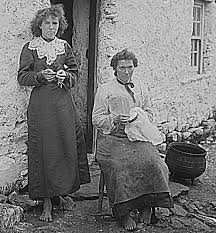Irish Lace and Women’s Independence
When we think of lacemaking, we can all be forgiven for having an image of a poor unfortunate peasant girl, sitting by a fire, needle and thread in hand with the last light of the last candle flickering away. Indeed this was the situation for many a lace maker. However, I’m going to be quite controversial here and offer a slightly more positive twist on the Irish Lace Story.
unfortunate peasant girl, sitting by a fire, needle and thread in hand with the last light of the last candle flickering away. Indeed this was the situation for many a lace maker. However, I’m going to be quite controversial here and offer a slightly more positive twist on the Irish Lace Story.
Ireland during the 19th century was an impoverished region. Most households depended on the little money they earned from agriculture and it was a time of great financial hardship. When the wife of the rector of Donaghmoyne, Mrs Grey Porter opened a lace school near Carrickmacross, at least one member of almost every family in the area was employed here. All of the lace makers were women. I cannot help but consider this as somewhat progressive. Not only were these women highlighting a woman’s role was not only in the home (at a time when a woman’s role was most definitely in the home!) but they were also making a significant contribution to the financial survival of their households.
Similarly, when the lace school was established in Youghal in the wake of the Great Famine, within 5 years a thriving business was operating employing up to 70 women and dozens more who were working from home. Amazing pieces of needlepoint lace were being produced for sale and export all around the world. The industry spread to a number of towns across the country including the town of Kenmare in the nearby Co. Kerry. Here a new school opened and employed hundreds of women locally. Not only had the town suffered greatly from the famine but the completion of the Holy Cross Church in 1864, meant a huge increase in unemployment as most of the men had been employed as labourers. Once again, the women of the town were able to find work and provide for their families.
Now, I’m fully aware that these were desperate times and people were more concerned with basic survival rather than any other greater social issues but I can’t help but feel the lacemaking industry in Ireland provided women with a sense of independence. In fact, Ireland was one of the few countries in the world where single women could emigrate because they were in a position to pay their own fare and they were in a position to do this from the money they earned from making lace.
When I was researching for my thesis I travelled to Clones to visit Mamo Mc Donald. Mamo is a bit of a lace expert, not as someone who makes lace but someone who talks about lace. She recalled a number of women who had bought farms with the money they made from lace and educated their children with the money they made from lace. So while lacemaking from an early stage became associated with poverty and hardship, there were clearly a few lace makers who saw it as an opportunity; an opportunity to earn money, an opportunity to provide and in effect an opportunity to become independent. By the turn of the 20th century, lacemaking was the 2nd largest industry in the country after agriculture! What an achievement! This is something I for one, am very proud of. So on this day Jan 6th 2016, which is known in Ireland as Women’s Little Christmas or Nollaig na mBan, I would like to give a nod to the lacemakers of Ireland for finding power in hardship and creating a sense of independence for Mná na hÉireann.


